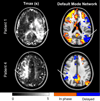Noncontrast mapping of arterial delay and functional connectivity using resting-state functional MRI: a study in Moyamoya patients
- PMID: 24419985
- PMCID: PMC4096618
- DOI: 10.1002/jmri.24558
Noncontrast mapping of arterial delay and functional connectivity using resting-state functional MRI: a study in Moyamoya patients
Abstract
Purpose: To investigate if delays in resting-state spontaneous fluctuations of the BOLD (sfBOLD) signal can be used to create maps similar to time-to-maximum of the residue function (Tmax) in Moyamoya patients and to determine whether sfBOLD delays affect the results of brain connectivity mapping.
Materials and methods: Ten patients were scanned at 3 Tesla using a gradient-echo echo planar imaging sequence for sfBOLD imaging. Cross correlation analysis was performed between each brain voxel signal and a reference signal comprised of either the superior sagittal sinus (SSS) or whole brain (WB) average time course. sfBOLD delay maps were created based on the time shift necessary to maximize the correlation coefficient, and compared with dynamic susceptibility contrast Tmax maps. Standard and time-shifted resting-state BOLD connectivity analyses of the default mode network were compared.
Results: Good linear correlations were found between sfBOLD delays and Tmax using the SSS as reference (r(2) = 0.8, slope = 1.4, intercept = -4.6) or WB (r(2) = 0.7, slope = 0.8, intercept = -3.2). New nodes of connectivity were found in delayed regions when accounting for delays in the analysis.
Conclusion: Resting-state sfBOLD imaging can create delay maps similar to Tmax maps without the use of contrast agents in Moyamoya patients. Accounting for these delays may affect the results of functional connectivity maps.
Keywords: BOLD contrast; MRI; Moyamoya disease; functional connectivity; perfusion; resting-state fMRI.
© 2014 Wiley Periodicals, Inc.
Conflict of interest statement
Figures




Similar articles
-
Erroneous Resting-State fMRI Connectivity Maps Due to Prolonged Arterial Arrival Time and How to Fix Them.Brain Connect. 2018 Aug;8(6):362-370. doi: 10.1089/brain.2018.0610. Brain Connect. 2018. PMID: 29886781 Free PMC article.
-
Mapping altered brain connectivity and its clinical associations in adult moyamoya disease: A resting-state functional MRI study.PLoS One. 2017 Aug 4;12(8):e0182759. doi: 10.1371/journal.pone.0182759. eCollection 2017. PLoS One. 2017. PMID: 28783763 Free PMC article.
-
Disentangling resting-state BOLD variability and PCC functional connectivity in 22q11.2 deletion syndrome.Neuroimage. 2017 Apr 1;149:85-97. doi: 10.1016/j.neuroimage.2017.01.064. Epub 2017 Jan 29. Neuroimage. 2017. PMID: 28143774
-
Evaluation of cerebrovascular reserve in patients with cerebrovascular diseases using resting-state MRI: A feasibility study.Magn Reson Imaging. 2019 Jun;59:46-52. doi: 10.1016/j.mri.2019.03.003. Epub 2019 Mar 5. Magn Reson Imaging. 2019. PMID: 30849484 Free PMC article.
-
Mapping cognitive and emotional networks in neurosurgical patients using resting-state functional magnetic resonance imaging.Neurosurg Focus. 2020 Feb 1;48(2):E9. doi: 10.3171/2019.11.FOCUS19773. Neurosurg Focus. 2020. PMID: 32006946 Free PMC article. Review.
Cited by
-
Changes in resting-state functional connectivity after stroke in a mouse brain lacking extracellular matrix components.Neurobiol Dis. 2018 Apr;112:91-105. doi: 10.1016/j.nbd.2018.01.011. Epub 2018 Jan 31. Neurobiol Dis. 2018. PMID: 29367009 Free PMC article.
-
A Resilient, Non-neuronal Source of the Spatiotemporal Lag Structure Detected by BOLD Signal-Based Blood Flow Tracking.Front Neurosci. 2017 May 11;11:256. doi: 10.3389/fnins.2017.00256. eCollection 2017. Front Neurosci. 2017. PMID: 28553198 Free PMC article.
-
Consensus statement on current and emerging methods for the diagnosis and evaluation of cerebrovascular disease.J Cereb Blood Flow Metab. 2018 Sep;38(9):1391-1417. doi: 10.1177/0271678X17721830. Epub 2017 Aug 17. J Cereb Blood Flow Metab. 2018. PMID: 28816594 Free PMC article. Review.
-
Abnormal dynamic functional connectivity is linked to recovery after acute ischemic stroke.Hum Brain Mapp. 2021 May;42(7):2278-2291. doi: 10.1002/hbm.25366. Epub 2021 Mar 2. Hum Brain Mapp. 2021. PMID: 33650754 Free PMC article.
-
BOLD delay times using group delay in sickle cell disease.Proc SPIE Int Soc Opt Eng. 2016 Feb-Mar;9784:97843M. doi: 10.1117/12.2217263. Epub 2016 Mar 21. Proc SPIE Int Soc Opt Eng. 2016. PMID: 30344364 Free PMC article.
References
-
- Fox MD, Raichle ME. Spontaneous fluctuations in brain activity observed with functional magnetic resonance imaging. Nat Rev Neurosci. 2007 Sep;8(9):700–711. - PubMed
-
- Van den Heuvel MP, Hulshoff Pol HE. Exploring the brain network: a review on resting-state fMRI functional connectivity. Eur Neuropsychopharmacol J Eur Coll Neuropsychopharmacol. 2010 Aug;20(8):519–534. - PubMed
-
- De Luca M, Beckmann CF, De Stefano N, Matthews PM, Smith SM. fMRI resting state networks define distinct modes of long-distance interactions in the human brain. NeuroImage. 2006 Feb 15;29(4):1359–1367. - PubMed
-
- Glover GH, Li TQ, Ress D. Image-based method for retrospective correction of physiological motion effects in fMRI: RETROICOR. Magn Reson Med Off J Soc Magn Reson Med Soc Magn Reson Med. 2000 Jul;44(1):162–167. - PubMed
-
- Lv Y, Margulies DS, Cameron Craddock R, Long X, Winter B, Gierhake D, et al. Identifying the perfusion deficit in acute stroke with resting-state functional magnetic resonance imaging. Ann Neurol. 2013 Jan;73(1):136–140. - PubMed
Publication types
MeSH terms
Substances
Grants and funding
LinkOut - more resources
Full Text Sources
Other Literature Sources
Medical

